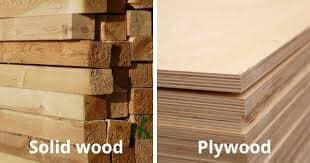Introduction
When it comes to choosing materials for construction, cabinetry, and furniture, plywood and solid wood are two of the most common options. Each has its own set of characteristics, benefits, and drawbacks. However, plywood often presents several distinct advantages over solid wood that make it a preferred choice for many applications. In this blog, we’ll delve into the key advantages of using plywood over solid wood, highlighting why plywood might be the ideal material for your next project.

1. Cost-Effectiveness
Plywood:
- Cost Savings: Plywood is generally more affordable than solid wood due to the manufacturing process, which uses less expensive raw materials. It is created by layering thin sheets of wood veneer, which are bonded together under pressure. This method makes plywood a cost-effective alternative, especially for large projects.
- Economic Choice: For budget-conscious projects, plywood offers a high-quality option without the premium price tag associated with solid wood.
Solid Wood:
- Higher Cost: Solid wood is often more expensive due to the cost of harvesting and processing whole lumber. The price can vary significantly based on the type of wood, with premium hardwoods like oak and mahogany being particularly costly.
2. Stability and Durability
Plywood:
- Resistance to Warping and Cracking: Plywood is engineered to resist warping, cracking, and splitting. The cross-grain construction of plywood—where layers are arranged with their grain at right angles—provides increased stability and resistance to dimensional changes caused by moisture and temperature fluctuations.
- Consistent Performance: Because plywood is manufactured with a consistent density and bonding process, it offers reliable performance and durability across its entire surface.
Solid Wood:
- Susceptible to Warping: Solid wood can be more prone to warping, cracking, and shrinking, especially in environments with high humidity or significant temperature changes. Its natural grain and growth patterns can make it less stable compared to engineered wood products.
3. Versatility and Ease of Use
Plywood:
- Wide Range of Applications: Plywood’s versatility allows it to be used in a variety of applications, including cabinetry, flooring, wall paneling, and furniture. Its ease of machining makes it suitable for custom designs and intricate details.
- Ease of Handling: Plywood is generally lighter and easier to handle than solid wood, making it more manageable for large projects and reducing the strain on tools and equipment.
Solid Wood:
- Limited Applications: While solid wood is prized for its aesthetic appeal and strength, it may not always be suitable for certain applications, such as large flat surfaces or projects requiring extensive machining.
4. Uniformity and Quality Control
Plywood:
- Consistent Quality: Plywood is manufactured to strict quality standards, which means it has a more uniform appearance and structural integrity compared to natural wood. The controlled production process minimizes defects and inconsistencies.
- Customizable Options: Plywood comes in various grades and finishes, allowing for customization based on specific project needs. It can be easily veneered or laminated to achieve the desired look.
Solid Wood:
- Natural Variations: Solid wood can have natural imperfections such as knots, grain inconsistencies, and color variations, which may affect its uniformity. While these characteristics can be desirable for some projects, they may be a drawback for others seeking a more consistent appearance.
5. Environmental Sustainability
Plywood:
- Efficient Use of Resources: Plywood makes efficient use of wood resources by utilizing smaller, faster-growing trees and reconstituting them into larger sheets. This process reduces waste and allows for more sustainable wood use.
- Recycled Content: Many plywood products incorporate recycled wood fibers and adhere to environmental standards, contributing to more sustainable practices in the woodworking industry.
Solid Wood:
- Resource Intensive: Harvesting solid wood, especially from mature trees, can be resource-intensive and may contribute to deforestation if not sourced sustainably. It often requires more wood volume to achieve the same surface area as plywood.
6. Lightweight and Easy to Transport
Plywood:
- Lightweight Construction: Plywood is generally lighter than solid wood, which makes it easier to transport and handle during construction or installation. This can reduce shipping costs and make the material more convenient for large-scale projects.
Solid Wood:
- Heavier Weight: Solid wood can be significantly heavier, which may increase transportation and handling costs and make it more cumbersome to work with, particularly for large pieces.
7. Cost-Effective for Large Projects
Plywood:
- Economical for Large Surfaces: For projects that require large surface areas, such as flooring or wall panels, plywood offers an economical solution compared to using solid wood. Its cost-effectiveness and ease of installation make it ideal for extensive projects.
Solid Wood:
- Higher Cost for Large Areas: Using solid wood for large surfaces can be prohibitively expensive and impractical due to its higher cost and potential for warping over large spans.
8. Improved Workability
Plywood:
- Ease of Cutting and Shaping: Plywood is easier to cut, shape, and machine compared to solid wood. It can be routed, drilled, and shaped without splintering, which allows for precise and clean finishes.
Solid Wood:
- Challenging Workability: Solid wood can be more challenging to work with due to its tendency to split or splinter, particularly along the grain. Specialized tools and techniques may be required to achieve desired results.
Conclusion
Plywood offers a range of advantages over solid wood, including cost-effectiveness, stability, versatility, and uniformity. Its engineered construction provides consistent performance, making it an excellent choice for various applications, from cabinetry and furniture to flooring and wall paneling. Additionally, plywood's sustainability and ease of handling contribute to its appeal in both residential and commercial projects.
While solid wood remains a valuable material with its own unique benefits and aesthetic qualities, plywood’s practical advantages make it a compelling option for many projects. By understanding these benefits, you can make an informed decision and select the material that best meets your needs and preferences.






